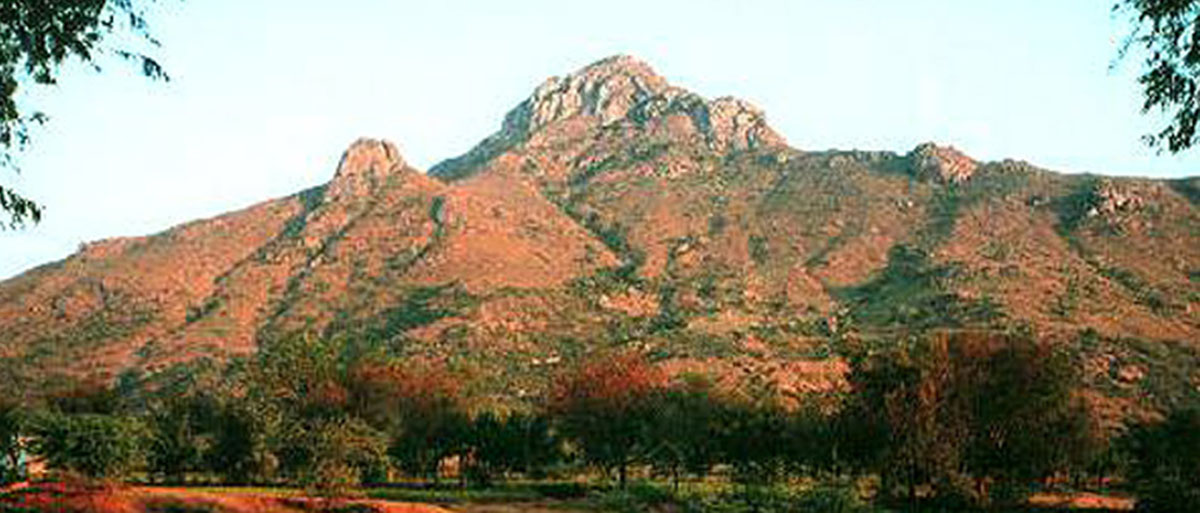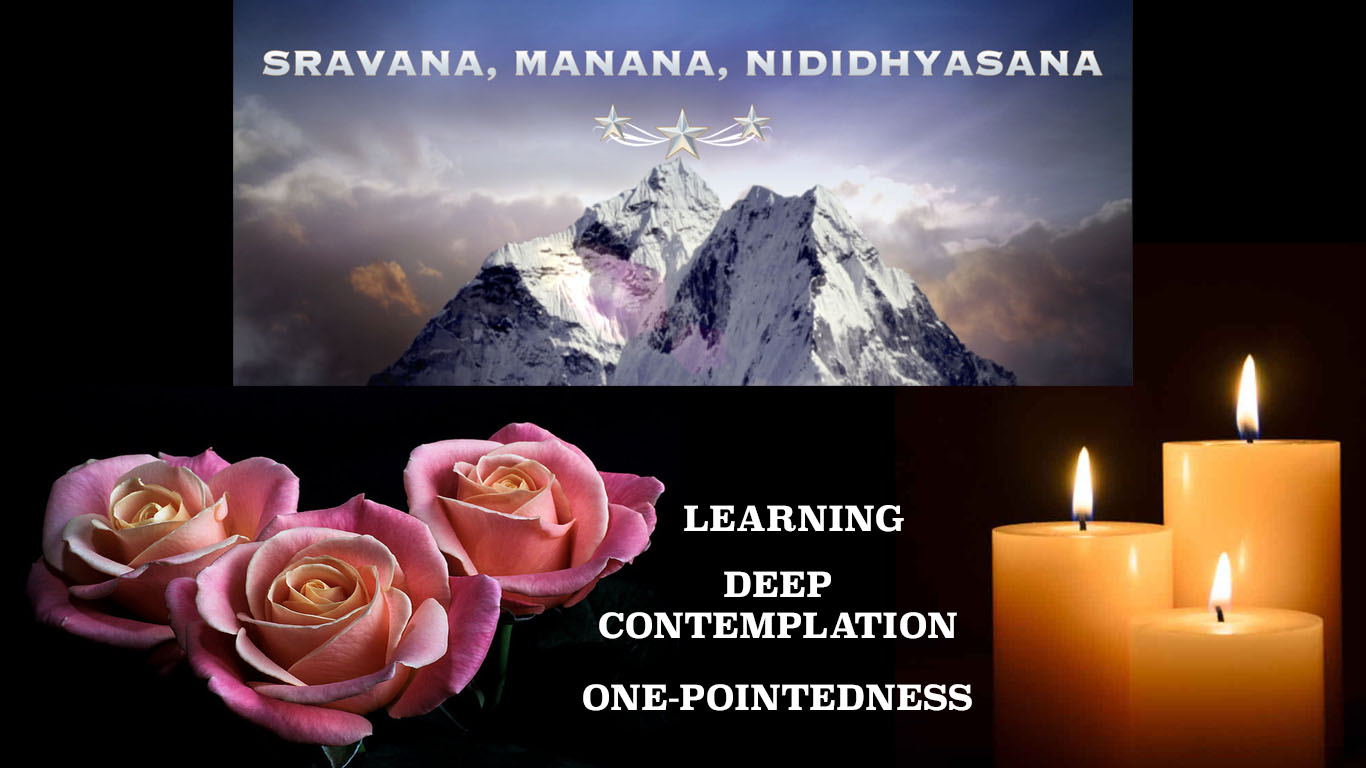Bhagavan Sri Ramana Maharshi

Sravana Manana Nididhyasana
Bhagavan Sri Ramana Maharshi has offered clear explanations for Sravana, Manana and Nididhyasana a few times. In general, Sravana means Learning, Manana means Contemplation, and Nididhyasana means Onepointedness or Steady Poise in the Self. Here I am presenting some of those explanations offered by Ramana Maharshi at different times in different ways.
========
Talks 349.
The first ever published Work of Bhagavan Sri Ramana Maharshi is His Tamil prose translation of Sri Adi Sankaracharya’s Viveka Chudamani in 1908. In this great work, Maharshi first wrote an introduction. In this introduction he offers explanations for Sravana (Learning), Manana (Contemplation) and Nididhyasana (Onepointedness or steady poise in the Self). Here are the excerpts from that introduction that relate to these three topics.
Every being in the world yearns to be always happy, free from the taint of sorrow; and desires to get rid of bodily ailments which are not of his true nature. Further, everyone cherishes the greatest love for oneself: and this love is not possible in the absence of happiness. In deep sleep, though devoid of everything, one has the experience of being happy. Yet, due to the ignorance of the real nature of one’s own being, which is happiness itself, people flounder in the vast ocean of material existence forsaking the right path that leads to happiness and act under the mistaken belief that the way to be happy consists in obtaining the pleasures of this and the other world.
But alas, that happiness, the bliss which has not the taint of sorrow is not realized. This Bliss is realized By jnana or Knowledge alone and jnana is achieved only through vichara or steady enquiry. In order to know this method of enquiry, one should seek the favour and instructions of a Guru. However, in order to realize the bliss of liberation, one’s own individual effort is an essential factor. Mere book-learning never yields this bliss. This bliss can be realized only through enquiry or vichara which consists of sravana or devoted attention to the precepts of the Guru, manana or deep contemplation and Nididhyasana or the cultivation of steady poise in the Self.
These are the three paths and their details are as follows.
The three bodies – physical, subtle and causal – are non-self and are unreal. The Self, or ‘I’, is quite different from them. It is due to ignorance that the sense of the Self or the ‘I’ notion is foisted on that which is not Self, and this indeed is bondage. Since from ignorance arises bondage, from Knowledge ensues liberation. To know this from the Guru is sravana, Learning.
To reject the three bodies consisting of the five sheaths (physical, vital, mental, gnostic and blissful) as not ‘I’ and to extract through subtle enquiry of “Who am I?” – even as the central blade of grass is delicately drawn out from its whorl – that which is different from all the three bodies and is existent as one and universal in the heart as Aham or ‘I’ and denoted by the words Tvam (in the Scriptural dictum – ‘Tat-tvam-asi’ – That thou art). This process of subtle enquiry is manana, deep contemplation.
The old tendencies of the mind sprout up thick and strong and form an obstruction (to that state of beatitude). These tendencies are threefold and egoism, which is their root, flourishes in the externalised and differentiating consciousness caused by the forces of vikshepa or dissipation (due to rajas) and avarana or envelopment (due to tamas).
To install the mind firmly in the heart until these forces are destroyed and to awaken with unswerving, ceaseless vigilance the true and cognate tendency which is characteristic of the Atman and is expressed by the dicta, Aham Brahmasmi (I am Brahman), and Brahmaivaham (Brahman alone am I) is termed nididhyasana or atmanusandhana, i.e., constancy or steady poise in the Self. This is otherwise called Bhakti, Yoga and Dhyana.
Atmanusandhana has been likened to churning the curd to draw forth butter, the mind being compared to the churning rod, the heart to the curd and the practice of constancy in the Self to the process of churning. Just as by churning the curd butter is extracted and by friction fire is kindled, even so, by unswerving vigilant constancy in the Self, ceaseless like the unbroken filamentary flow of oil, is generated the natural or changeless trance or nirvikalpa samadhi, which readily and spontaneously yields that direct, immediate, unobstructed and universal perception of Brahman, which is at once Knowledge and Experience and which transcends time and space.
This is Self-Realization; and thereby The false delusions of ignorance, the vicious and age-long tendencies of the mind, are destroyed. All doubts are dispelled and the bondage of Karma is severed. This is the limitless bliss of liberation, beyond doubt and duality. To realize this state of freedom from duality is the summum bonum of life: and he alone that has won it is a jivanmukta (the liberated one while yet alive), and not he who has merely a theoretical understanding.
========
Talks 249.
To a Devotee, Ramana Maharshi explained Sravana, Manana and Nididhyasana as follows.
Aids are meant for eradicating thoughts; these thoughts are the re-manifestations of predispositions remaining in seed-form; they give rise to diversity from which all troubles arise. These aids are: hearing the truth from the master (sravana), etc.
The effects of sravana may be immediate and the disciple realizes the truth all at once. This can happen only for the well-advanced disciple. Otherwise, the disciple feels that he is unable to realize the truth, even after repeatedly hearing it. What is it due to? Impurities in his mind: ignorance, doubt and wrong identity are the obstacles to be removed.
(a) To remove ignorance completely, he has to hear the truth repeatedly, until his knowledge of the subject-matter becomes perfect; This is Sravana.
(b) to remove doubts, he must reflect on what he has heard; ultimately his knowledge will be free from doubts of any kind; This is Manana.
(c) to remove the wrong identity of the Self with the non-self (such as the body, the senses, the mind or the intellect) his mind must become one-pointed. This is Nididhyasana.
All these things accomplished, the obstacles are at an end and samadhi results, that is, Peace reigns.
Some say that one should never cease to engage in hearing, reflection and one-pointedness. These are not fulfilled by reading books, but only by continued practice to keep the mind withdrawn.
The aspirant may be kritopasaka or akritopasaka. The former is fit to realize the Self, even with the slightest stimulus: only some little doubt stands in his way, it is easily removed if he hears the truth once from the Master. Immediately he gains the samadhi state. It is presumed that he had already completed sravana, reflection, etc. in previous births, they are no more necessary for him.
For the other all, these aids are necessary; for him doubts crop up even after repeated hearing; therefore he must not give up aids until he gains the samadhi state.
Sravana removes the illusion of the Self being one with the body and so on. Reflection makes it clear that True Knowledge, Reality is the Self. One- pointedness reveals the Self as being Infinite and Blissful.
The Devotee asked:
Having heard this truth, why does not one remain content?
Maharshi answered :
Because samskaras, predispositions or deep mental tendencies, have not been destroyed. Unless the samskaras cease to exist, there will always be doubt and confusion (sandeha, viparita). All efforts are directed to destroying doubt and confusion. To do so their roots must be cut. Their roots are the samskaras. These are rendered ineffective by practice as prescribed by the Guru. The Guru leaves it to the seeker to do this much so that he might himself find out that there is no ignorance. This truth mentioned is in the stage of the hearing of the Truth (sravana). That is not drdha (firm). For making it unshaken, one has to practise reflection (manana) and one-pointedness (nididhyasana). These two processes scorch the seeds of vasanas so that they are rendered ineffective.
Some extraordinary persons get drdha jnana (unshaken knowledge) even on hearing the Truth only once (sakrchhravana matrena). Because they are krthopasakah (advanced seekers), whereas the akrthopasakah (raw seekers) take longer to gain drdha jnana (unshaken knowledge).
D.: Why then do I not realize it?
M.: Because of the samskaras, predispositions, deep mental tendencies. However, find out who does not realize and what he does not realize. Then it will be clear that there is no avidya (ignorance).
========
Talk 647.
To another Devotee, Maharshi explained Sravana, Manana and Nididhyasana as follows.
By sravana, Knowledge dawns. That is the flame.
By manana, the Knowledge is not allowed to vanish.
By nididhyasana, the flame is kept up to burn bright by trimming the wick. Just as the flame is protected by a wind-screen, so the other thoughts are not allowed to overwhelm the right knowledge. By nididhyasana the flame is kept up to burn bright by trimming the wick. Whenever other thoughts arise, the mind is turned inward to the light of true knowledge. When this becomes natural, it is samadhi.
The enquiry “Who am I?” is the sravana.
The ascertainment of the true import of `I’ is the manana.
The practical application on each occasion is nididhyasana.
Being as `I’ is samadhi.
========


